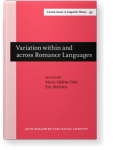The role of the copula in the diachronic development of focus constructions
in Portuguese
Old and Classic Portuguese had two positions for contrastive focus: one at the sentence initial position, followed by the verb, a ‘V2’ sort of pattern (XPVS), and one at the sentence final position, constituting the Romance post-verbal subject (V(XP)S). This paper analyzes the role of the copula in the innovations that occurred in Modern Portuguese focus structures: (a) the expansion of cleft constructions, from wh-clefts to that-clefts, (b) from inverse clefts to canonical clefts and (c) the reduction of that-clefts, a grammaticalization that affected only Brazilian Portuguese (BP). In European Portuguese (EP), XPVS and V(XP)S survive together with modern clefts while in BP clefts and reduced clefts took over the old constructions completely.
References (31)
References
Ambar, Manuela. 1992. Para uma sintaxe da inversão sujeito-verbo em Português. Lisboa: Edições Colibri.
Barbosa, Pilar. 2001. “On Inversion in Wh-questions in Romance”. Romance Inversion ed. by Alfke Hulke & Jean-Yves Pollock, 2–59. Oxford: Oxford University Press.
Belletti, Adriana. 2004. “Aspects of the Low IP Area”. The Structure of IP and CP: The cartography of syntactic structures 2 ed. by Luigi Rizzi, 16–51. Oxford: Oxford University Press.
Berlinck, Rosane de Andrade. 2000. “Brazilian Portuguese VS Order: A diachronic analysis.” Brazilian Portuguese and the Null Subject Parameter ed. by Mary A. Kato & Esmeralda V. Negrão, 175–194. Frankfurt am Main: Vervuert.
Casteleiro, João. M. 1979. “Sintaxe e semântica das construções enfáticas com “é que””. Boletim de Filologia XXV.97–1166.
Chomsky, Noam. 2007. “Approaching UG from Below”. Interfaces + Recursion = Language? ed. by Uri Sauerland & Hans-Martin Gärtner, 1–29. Berlin: Mouton de Gruyter.
Costa, João. 1998. Word Order Variation: A constraint-based approach. The Hague: Holland Acedemic Graphics.
Costa, João & Ana Maria Martins. 2011. “On Focus Movement in European Portuguese”. Probus 23.217–245. 

Duarte, M. Eugenia. 1992. “A perda da ordem VS em interrogativas-Qu no Português do Brasil”. DELTA 8.37–52.
Duarte, M. Eugenia. 1993. “Do pronome nulo ao pronome pleno”. O Português Brasileiro: Uma viagem diacrônica ed. by Ian Roberts & Mary A. Kato, 107–128. Campinas: Editora da Unicamp.
Duarte, M. Eugenia. 1995. A perda do princípio ‘Evite pronome’ no Português Brasileiro. Ph.D. dissertation, UNICAMP.
Hornstein, Norbert, Jairo Nunes & Kleanthes Grohmann. 2005. Understanding Minimalism. Cambridge: Cambridge University Press. 

Jespersen, Otto. 1937. Analytic Syntax. London: Allen & Unwin.
Kato, Mary A, M. Luiza Braga, M. Aparecida Lopes-Rossi, & Nilmara Sikansi. 1996. “As constuçoes-Q no Português Brasileiro”. Gramática do Português Falado ed. by Inegedore Villaça Koch, Vol. VI, 303–370. Campinas: Editora da Unicamp.
Kato, Mary A. 2007. “Free and Dependent Small Clauses in Brazilian Portuguese”. DELTA 23 (Especial): Homenagem a Lucia Lobato, 85–111. 

Kato, Mary A. & Sonia M.L. Cyrino. 2010. “On semi-clefts and IP ellipsis in Portuguese”. Paper presented at the Linguistics Symposium on Romance Languages, 41, Ottawa, Canada, May 2011.
Kato, Mary A. 2012. “Variation in Wh-Questions in Brazilian Portuguese”. Paper presented at The Second Cambridge Colloquium on the Histories of the Ibero-Romance Languages –Norman MacColl Symposium 2012.
Kato, Mary A. & Eugenia M. Duarte. 2002. “A Diachronic Analysis of Brazilian Portuguese Wh-Questions”. Santa Barbara Portuguese Studies 6.326–339. University of California at Santa Barbara, Center for Portuguese Studies.
Kato, Mary A. & Esmeralda V. Negrão. 2000. Brazilian Portuguese and the Null Subject Parameter. Frankfurt: Vervuert-IberoAmericana.
Kato, Mary A. & Eduardo Raposo. 1996. “European and Brazilian Word Order: Questions, focus and topic constructions”. Aspects of Romance Linguistics ed. by Claudia Parodi, A. Carlos Quicoli, Mario Saltarelli & Maria-Luisa Zubizarreta, 267–278. Washington: Georgetown University Press.
Lambrecht, Knud. 2001. “A Framework for the Analysis of Cleft Constructions”. Linguistics 39.463–516. 

Lopes-Rossi, M. Aparecida. 1996. A sintaxe diacrônica das interrogativas-Q do Português. Ph.D. dissertation, UNICAMP.
Modesto, Marcelo. 2001. As Construções Clivadas no Português do Brasil. São Paulo: Humanitas.
Nunes, Jairo. 2004. Linearization of Chains and Sideward Movement. Cambridge, Mass.: MIT Press.
Ordoñez, Francisco & Antxon Olarrea. 2006. “Microvariation in Caribbean-non Caribbean Spanish Interrogatives”. Probus 18.59–97. Berlin: Mouton de Gruyter. 

Resenes, Mariana S. de. 2009. Sentenças Pseudo-Clivadas do Português Brasileiro. M.A. Thesis, Florianópolis, UFSC.
Ribeiro, Ilza. 1995. “Evidence for a Verb-Second Phase in Old Portuguese”. Clause Structure and Language Change ed. by Adrian Battye & Ian Roberts, 110–139. Oxford: Oxford University Press.
Rizzi, Luigi. 1997. “The Fine Structure of the Left Periphery”. Elements of Grammar ed. by Liliane Haegeman, 281–338. Dordrecht: Kluwer. 

Rizzi, Luigi & Ian Roberts. 1989. “Complex Inversion in French”. Probus 1.1–30. 

Uriagereka, Juan. 1995. “An F Position in Western Romance”. Discourse Configurational Languages ed. by Katalin É. Kiss, 153–175. Oxford: Oxford University Press.
